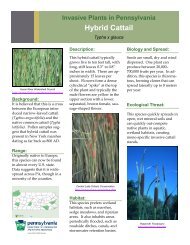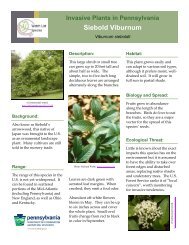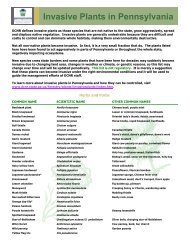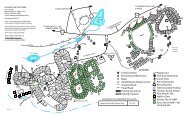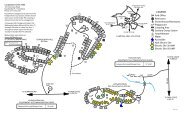Why should I care about native plants? - Pennsylvania Department ...
Why should I care about native plants? - Pennsylvania Department ...
Why should I care about native plants? - Pennsylvania Department ...
You also want an ePaper? Increase the reach of your titles
YUMPU automatically turns print PDFs into web optimized ePapers that Google loves.
Visit iConservePA.org for a larger list of<br />
<strong>native</strong> <strong>plants</strong>, <strong>native</strong> plant nurseries,<br />
garden templates & more!<br />
Commomwealth of <strong>Pennsylvania</strong><br />
<strong>Department</strong> of Conservation and Natural Resources<br />
Cooperating Partners:<br />
<strong>Why</strong> <strong>should</strong> I <strong>care</strong> <strong>about</strong> <strong>native</strong> <strong>plants</strong>?<br />
Native <strong>plants</strong> create beautiful landscapes that provide <strong>native</strong> wildlife with the<br />
best habitat and food they need to survive. Native <strong>plants</strong> also help to protect<br />
watersheds and maintain the unique natural heritage of an area.<br />
In <strong>Pennsylvania</strong>, our <strong>native</strong> <strong>plants</strong> lend a sense of place that is recognized<br />
and enjoyed by citizens and visitors from all over the world. If our <strong>native</strong><br />
<strong>plants</strong> continue to be replaced with species from other places, <strong>Pennsylvania</strong><br />
will lose the natural beauty and resources that define the state.<br />
Not only do <strong>native</strong> <strong>plants</strong> provide benefits to the environment as a whole, they<br />
also provide value to you and your backyard. Because <strong>Pennsylvania</strong>’s <strong>native</strong><br />
<strong>plants</strong> are meant to grow here, they thrive with less maintenance in the right<br />
conditions, thereby reducing the need to water and fertilize them. They also<br />
serve as pollinators and attract wildlife.<br />
What is a <strong>native</strong> plant?<br />
A <strong>native</strong> plant is one that occurred within the state before settlement by<br />
Europeans. Native <strong>plants</strong> include ferns and clubmosses; grasses, sedges,<br />
rushes, and their kin; flowering perennials; annuals, which only live one<br />
year; biennials, which have a two-year life cycle; and, of course, the woody<br />
trees, shrubs, and vines that covered “Penn’s Woods” when the first settlers<br />
arrived. More than 2,100 <strong>native</strong> plant species make up the botanical diversity<br />
of <strong>Pennsylvania</strong>.<br />
A “growing” problem<br />
Shady/<br />
Moist<br />
While new <strong>plants</strong> are coming into <strong>Pennsylvania</strong>, <strong>native</strong> <strong>plants</strong> are being lost<br />
to habitat destruction, invasive <strong>plants</strong>, and introduced pests and diseases. By<br />
2000, five percent of <strong>Pennsylvania</strong>’s <strong>native</strong> plant species had been eliminated<br />
and another 25 percent were in danger of becoming extinct. The good news<br />
is that action can be taken to protect and enhance the remaining diversity of<br />
these beautiful and often useful plant species.<br />
An introduced or non-<strong>native</strong> plant is one that has been brought into the<br />
state and become established. At the turn of the 21st century, <strong>about</strong> 1,300<br />
species of non-<strong>native</strong> <strong>plants</strong> existed in <strong>Pennsylvania</strong>. That is 37 percent of<br />
<strong>Pennsylvania</strong>’s total plant flora (<strong>about</strong> 3,400 species), and more introduced<br />
<strong>plants</strong> are identified every year.<br />
An invasive plant is a species that has become a weed pest—one that grows<br />
aggressively, spreads, and displaces other <strong>plants</strong>. Although some <strong>native</strong><br />
<strong>plants</strong> are aggressive on disturbed areas, most invasive <strong>plants</strong> are introduced<br />
from other regions, leaving behind the pests, diseases, predators, and other<br />
natural controls that usually keep them in check.
Shady/Moist<br />
Christmas fern<br />
This evergreen fern is easy to grow in all soil types. It is a<br />
host plant for some butterfly larvae.<br />
Black-gum<br />
The black-gum explodes in the fall with vivid, red foliage<br />
and abundant blue fruit—making it an outstanding<br />
ornamental selection. The tree is picturesque in the winter<br />
when stark horizontal branches reach in every direction.<br />
Spicebush<br />
Bearing scarlet berries at summer’s end, this fragrant<br />
shrub releases the scent of allspice when its leaves and<br />
twigs are crushed. It is a vital host plant to butterflies in the<br />
swallowtail family.<br />
Highbush blueberry<br />
Gobs of delicious fruit—larger than that of its lowbush<br />
cousin—are the reward for planting highbush blueberry,<br />
prized by people and wildlife. In late spring, the plant is<br />
adorned with small, bell-shaped white flowers.<br />
Maidenhair fern<br />
This plant is great for clumping in cool, shady spots in<br />
woodland gardens or rock gardens. It has a distinctive,<br />
delicate texture.<br />
River birch<br />
Peeling bark—light on one side, cinnamon brown on the<br />
other—is a striking feature of this tree, well-suited for moist<br />
areas but tolerant of drier conditions. It is often available in<br />
multi-trunk forms.<br />
Wild geranium<br />
The first flowers appear as early as April on this longblooming,<br />
adaptable perennial. It spreads well in the garden<br />
and is a good source of nectar.<br />
Jacob’s ladder<br />
This is an attractive, small plant for a shade garden. Pale<br />
blue flowers are complemented by ladder-like foliage. It was<br />
historically used in herbal medicines.<br />
DCNR’s Backyard Best Bets<br />
were chosen based on their<br />
hardiness potential in any<br />
soil condition, availability in<br />
the nursery trade, wildlife and<br />
habitat benefit, and viability in<br />
the overall ecosystem.<br />
Shady/Moist<br />
Key for Symbols<br />
Attracts Birds<br />
Nectar Plant<br />
Deer Resistant<br />
Drought Resistant<br />
Edible<br />
Colorful Fall Leaves<br />
Attracts Wildlife<br />
Evergreen<br />
Fragrant<br />
Durable Plants<br />
Ground Cover
Shady/Moist<br />
Trees Size Bloom<br />
Period<br />
Red maple<br />
Acer rubrum<br />
Sugar maple<br />
Acer saccharum<br />
Black (Sweet) birch<br />
Betula lenta<br />
River birch<br />
Betula nigra<br />
Alternate-leaved (Pagoda)<br />
dogwoodCornus alternifolia<br />
Green ash<br />
Fraxinus pennsylvanica<br />
Black-gum<br />
Nyssa sylvatica<br />
Pin oak<br />
Quercus palustris<br />
Bloom/Fruit<br />
40-100’ Mar-Apr red flowers<br />
60-100’ Apr-May yellow flowers<br />
50-75’ Apr-May greenish catkins<br />
60-80’ Apr-May brown catkins<br />
15-25’ May-Jun white flowers<br />
30-50’ Apr-May yellow flowers<br />
30-75’ Apr-May dark blue fruit<br />
60-70’ Apr-May<br />
Shrubs Size Bloom Bloom/Fruit<br />
Period<br />
Smooth alder<br />
Alnus serrulata<br />
6-10’ Mar-Apr yellow catkins<br />
Black chokeberry<br />
Photinia (Aronia) melanocarpa<br />
3-6’ Apr-May dark blue berries<br />
Buttonbush<br />
Cephalanthus occidentalis<br />
Silky dogwood<br />
Cornus amomum<br />
Wild hydrangea<br />
Hydrangea arborescens<br />
Winterberry<br />
Ilex verticillata<br />
Mountain laurel<br />
Kalmia latifolia<br />
Spicebush<br />
Lindera benzoin<br />
Ninebark<br />
Physocarpus opulifolius<br />
Rosebay<br />
Rhododendron maximum<br />
Black willow<br />
Salix nigra<br />
Silky willow<br />
Salix sericea<br />
Highbush blueberry<br />
Vaccinium corymbosum<br />
Maple-leaved viburnum<br />
Viburnum acerifolium<br />
Arrow-wood<br />
Virburnum recognitum<br />
6-15’ Jun-Sep creamy white<br />
flowers<br />
6-12’ May-Jun bluish berries<br />
3-6’ Jun-Aug white flowers<br />
6-10’ May-Jun red berries<br />
12-20’ May-Jul white to pink<br />
flowers<br />
6-12’ Mar-May bright yellow<br />
flowers<br />
5-10’ May-Jul pink to white<br />
flowers<br />
10-30’ Jun-Jul rose pink flowers<br />
30-50’ Apr-May yellow catkins<br />
Ferns (continued) Size Bloom<br />
Period<br />
Christmas fern<br />
Polystichum achrostichoides<br />
Ostrich fern<br />
Metteucia struthiopteris<br />
Royal fern<br />
Osmunda regalis<br />
Cinnamon fern<br />
Osmunda cinnamomea<br />
Lady fern<br />
Athyrium felix -femina<br />
1-2’<br />
2’-3’<br />
1’-2’<br />
1’-2’<br />
2’-3’<br />
Bloom/Fruit<br />
Perennials/Vines Size Bloom Bloom/Fruit<br />
Period<br />
Wild columbine<br />
Aquilegia canadensis<br />
Jack-in-the-pulpit<br />
Arisaema triphyllum<br />
Wild ginger<br />
Asarum canadense<br />
White wood aster<br />
Eurybia (Aster) divaricatus<br />
Marsh marigold<br />
Caltha palustris<br />
Blue cohosh<br />
Caulophyllum thalictroides<br />
Black cohosh<br />
Actea racemosa<br />
Turtlehead<br />
Chelone glabra<br />
Dutchman’s breeches<br />
Dicentra cucullaria<br />
Wild geranium<br />
Geranium maculatum<br />
Sneezeweed<br />
Helenium autumnale<br />
Alumroot<br />
Heuchera americana<br />
Cardinal flower<br />
Lobelia cardinalis<br />
Great blue lobelia<br />
Lobelia siphilitica<br />
Virginia bluebells<br />
Mertensia virginica<br />
Wild blue phlox<br />
Phlox divaricata<br />
Wild sweet William<br />
Phlox maculata<br />
Garden phlox<br />
Phlox paniculata<br />
Jacob’s ladder<br />
Polemonium reptans<br />
Great solomon’s seal Polygonatum<br />
commutatum (bilforum, canaliculatum)<br />
Golden ragwort<br />
Packera aurea (Senecio aureus)<br />
Tall meadow-rue<br />
Thalictrum pubescens (polygamum)<br />
Foamflower<br />
Tiarella cordifolia<br />
1-3’ Apr-Jun red-yellow<br />
flowers<br />
1-3’ Apr-Jun green-purple<br />
flowers<br />
< 1’ Apr-May maroon flowers<br />
1-3’ Jul-Oct white flowers<br />
1-2’ Apr-Jun bright yellow<br />
flowers<br />
1-2.5’ Apr-Jun green-yellow<br />
flowers<br />
3-8’ Jun-Sep white flowers<br />
1-3’ Jul-Sep white-pink<br />
flowers<br />
< 1’ Apr-May white to cream<br />
1-2’ Apr-Jul lavender-pink<br />
flowers<br />
2-6’ Aug-Oct yellow flowers<br />
1-2’ May-Aug greenish flowers<br />
2-5’ Jul-Sep scarlet flowers<br />
1-4’ Jul-Oct blue flowers<br />
1-2.5’ Mar-Jun pink-blue flowers<br />
1-2’ May-Jun lilac flowers<br />
1-3’ Jun-Sep purple flowers<br />
2-5’ Jul-Oct pink flowers<br />
1-2’ Apr-Jun blue flowers<br />
3-6’ Apr-Jun white-green<br />
flowers<br />
1-2’ Apr-Jul yellow flowers<br />
2-9’ May-Jun white flowers<br />
< 1’ Apr-Jul white flowers








